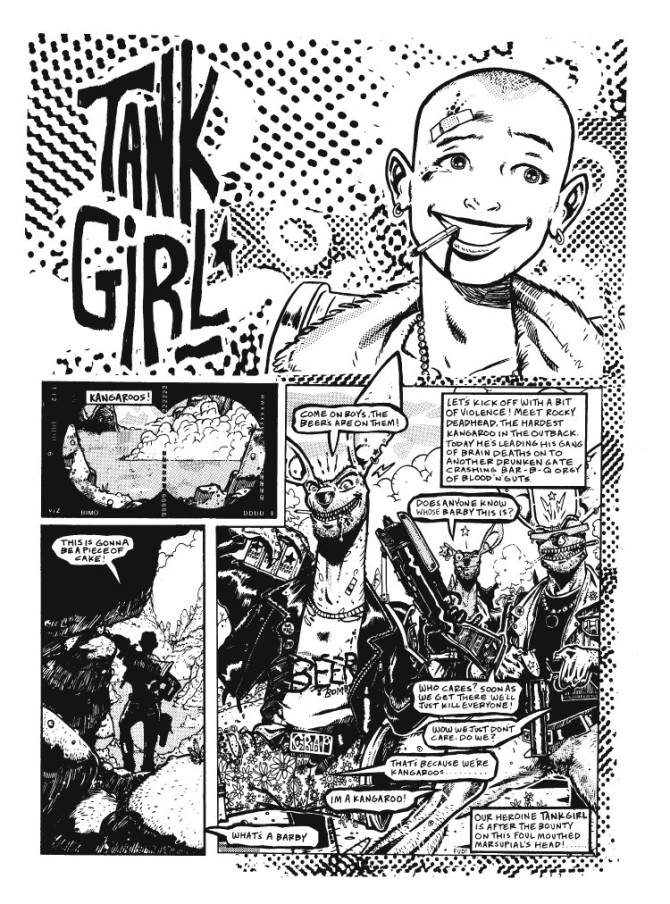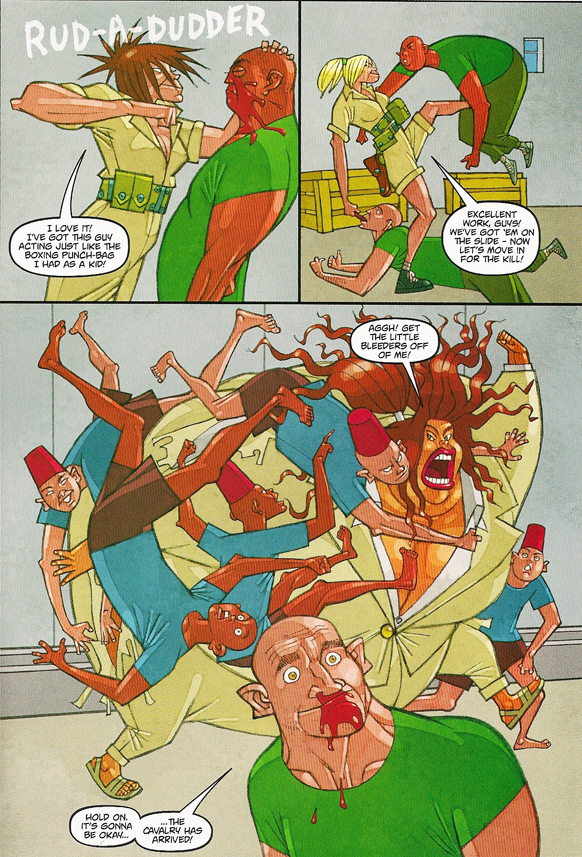Review – Tank Girl: Carioca
Posted 8 years ago by Rob Lammle Comics

Back in the late-80s and early-90s, back when the rough-and-ready, bald-headed, cigarette-smoking, missle-breasted Aussie badass known as Tank Girl was in her heyday, about as “indie” as I got was the Eastman & Laird Teenage Mutant Ninja Turtles . For a certain group of people of a certain age, she was an icon. I was not one of those people. I wasn’t a rebellious sort who hated his father and fought against the establishment. I didn’t have any odd holes in my face. I had a very conservative haircut. I had never even once raged against the machine. Although my attitudes have changed somewhat over the years, I still never found my way to Tank Girl. I just never made the effort. Until I was offered the chance to review Tank Girl: Carioca from Titan Books, and then there she was, staring me down, daring me to take her on.
I read Carioca and, well, it didn’t do much for me. The plot felt loose, misguided, and random. If I’d stopped there, I probably wouldn’t have given it a very good review. Honestly, I didn’t quite see what the big deal was with this Tank Girl anyway. However, I felt like that was dismissive. I needed some context; I needed a Tank Girl education. But being the nerd, the straight arrow, the square that I am, I didn’t go digging through every back issue long box of every comic book store in St. Louis…I didn’t ask some tattooed roller girl if I could borrow her dog-eared copies that she used to hide from her parents when she was in middle school…I didn’t even bittorrent them like a modern pixel rebel should. No, I went to the library. And, because my library is cooler than I am, they had not one, not two, but five collections of Tank Girl comics. I grabbed the first three and headed home to start reading.
As it turns out, even the old Tank Girl is loose, misguided, and random. But that’s part of her charm. The early comics don’t really feature a story per se, as they were part of an anthology comic book magazine called Deadline that highlighted the best and the brightest of the alternative UK comic scene. But even as some of the later strips had stories that arched over multiple issues, the stories were still unconventional and erratic. I can completely understand why she was such an important figure for those more rebellious of our generation. She’s the embodiment of that part of us that wants to give a middle finger to the world, who doesn’t care about anything other than where our next drink is coming from. In addition, she’s sexy in every unconventional sense of the word.
With my Tank Girl primer complete, I read Carioca again. I now understood that the story, written by co-creator and original author Alan Martin, is supposed to be a bit loose and nonsensical. In this case, TG and her anthropomorphized kangaroo boyfriend Booga were just about to win some sweet mountain bikes on a TV quiz show, when the host, Charlie Happy, fixed the game in order to see them lose, just because he didn’t like their type. After the insult is discovered, TG and Booga gather their Thunderdome reject friends and murder Happy in a ridiculous Rube Goldeberg-esque fashion. Then they hightail it to the Outback to hide from Johnny Law. While there, Tank Girl has a Jesus-like revelation in the wilderness, after which she changes her tune completely. She will no longer be a vehicle of madness, destruction, and wanton violence. Instead, she and her friends will dress in white robes, eat a vegetarian diet, focus on their chakras, and follow the way of her new movement, dubbed “Carioca”. In somewhat fitting fashion, her new philosophy is named after a divebar where she claims is the one place she ever felt completely at peace. Despite their new, peaceful ways, trouble and violence keep finding them, namely in the form of assassins hired by Charlie Happy’s morbidly obese wife who is looking for revenge.
Although there is still that familiar feeling of randomness, Martin tells the reader in the foreword that this is unlike any other Tank Girl comic that he’s written. And I see what he means: Carioca has a point. Moving beyond mere spurts of violence and beer swilling, Martin wants readers to understand that we have the power within ourselves to defeat those forces that are trying to hold us back. But the moral of the story isn’t beaten over your head. Instead, it gets stuck in between a samurai having his own sword shoved down his throat and exiting the bottom of his foot, and more than one person getting their head kicked clean off. Still, it is there, and in some ways it’s a welcome addition. At the same time, the moral gets overpowered by the heads getting kicked clean off, so it gets lost in all of the blood-letting. Not to say the blood-letting and foot-powered decapitations aren’t fun – they are – , but something just felt a little off for me in Carioca. There’s not any one thing exactly; it just didn’t gel.
The artwork of the original comic was, and still is, revolutionary. Every corner of every panel was crammed full of stuff – characters, beer cans, guns, bullets, and word balloons – making the visuals as chaotic as the plotlines. And while Jamie Hewlett’s work was the perfect fit for Tank Girl, he’s gone on to bigger and better things as one of the geniuses behind the excellent cartoon band, Gorillaz. In his place for Carioca is Mick McMahon, another influential British comic book artist whose work on Judge Dredd helped define the still-popular character back in the late-1970s. His angular, flat aesthetic, and Technicolor brightness is a stark contrast to Hewlett’s raw, overly-detailed art, but it still works rather well for this out-of-the-box character. There’s no question at all that it’s stylized, but I don’t think Tank Girl would have it any other way. It’s a very different take on the character and her world, but it still suits her just fine.
In the end, I feel like Carioca was a mixed bag for me. What message there was to be garnered from the story was minimal, and sometimes it felt like it was just getting in the way. But I have to give Martin some kudos for trying something new, especially when he could have easily just rested on his laurels and put out anything with the Tank Girl name and it would have sold just as well. That being said, I did sort of miss the chaos that I’ve only just recently discovered thanks to my local library. Of course I haven’t been writing those types of stories for the last 30 years, so the old style is still fresh and exciting to me, whereas Martin’s probably ready to move on. If this was his first foray into a more serious side of Tank Girl, it’s a fine baby step. I honestly feel that with maybe another read-through or two, it could grow on me. For now, though, I’m glad I still have those old collections checked-out from the library for another two weeks.




